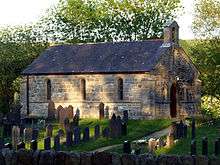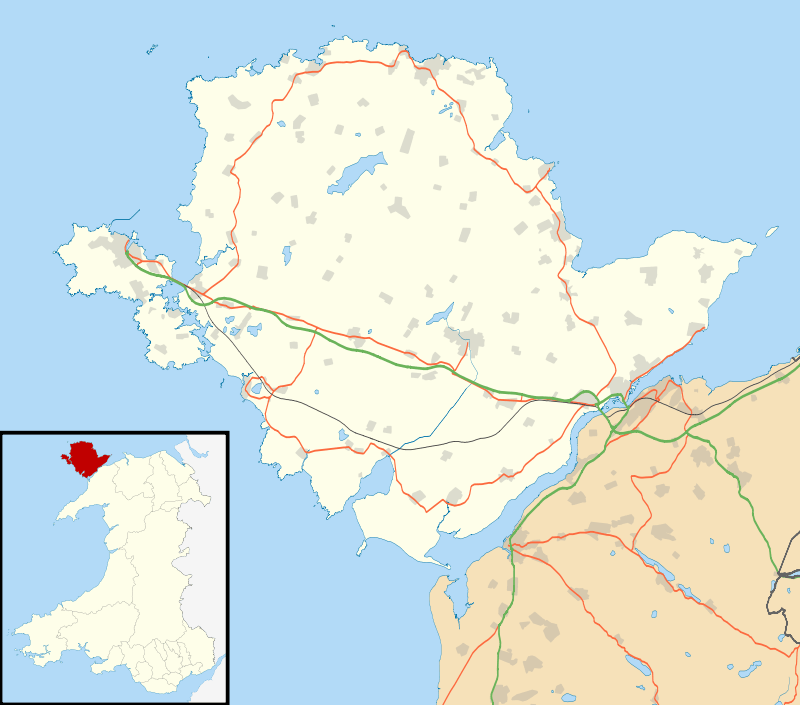St Ffinan's Church, Llanffinan
St Ffinan's Church, Llanffinan is a small 19th-century parish church built in the Romanesque revival style, in Anglesey, north Wales. There has been a church in this area, even if not on this precise location, since at least 1254, and 19th-century writers state that St Ffinan established the first church here in the 7th century. The church was rebuilt in 1841, reusing a 12th-century font and 18th-century memorials, as well as the cross at the eastern end of the roof.
| St Ffinan's Church, Llanffinan | |
|---|---|
 The church from the north, showing the doorway at the west end | |
 St Ffinan's Church, Llanffinan Location in Anglesey | |
| OS grid reference | SH 495 755 |
| Location | Llanffinan, Anglesey |
| Country | Wales, United Kingdom |
| Denomination | Church in Wales |
| Website | Church website |
| History | |
| Status | Parish church |
| Founded | c. 620 Present building 1841 |
| Dedication | St Ffinan |
| Architecture | |
| Functional status | Active |
| Heritage designation | Grade II |
| Designated | 30 January 1968 |
| Architect(s) | John Welch (1841) |
| Architectural type | Church |
| Style | Romanesque revival |
| Specifications | |
| Materials | Stone with slate roof |
| Administration | |
| Parish | Bro Cadwaladr |
| Deanery | Synod Ynys Mon |
| Archdeaconry | Bangor |
| Diocese | Diocese of Bangor |
| Province | Province of Wales |
| Clergy | |
| Vicar(s) | The Reverend E C Williams |
| Assistant priest(s) | The Reverend E R Roberts |
The church is still used for worship by the Church in Wales, one of eight in a combined parish, and services are held weekly. It is a Grade II listed building, a national designation given to "buildings of special interest, which warrant every effort being made to preserve them",[1] in particular because it is considered to be "a good essay in a simple Romanesque revival style".[2] The church is at the end of a gravel track in the countryside of central Anglesey, about 2.5 kilometres (1.6 mi) from Llangefni, the county town. It is also on a footpath to Plas Penmynydd, once home to Owen Tudor, founder of the Tudor dynasty.
History and location
St Ffinan's Church is in the countryside in the centre of Anglesey, north Wales, near the village of Talwrn, and about 2.5 kilometres (1.6 mi) away from Llangefni, the county town of Anglesey.[2] The parish church is at the end of a gravelled track, off a country lane between the lower part of Talwrn and the hamlet of Ceint to the south.[3] It can also be accessed by public footpath from Plas Penmynydd, once home to Owen Tudor, grandfather of King Henry VII and founder of the Tudor dynasty.[3][4] The parish takes its name from the church: the Welsh word llan originally meant "enclosure" and then "church", with "-ffinan" denoting the saint.[5]
The date of construction of the first church in this area is uncertain, although a church was recorded here in 1254 during the Norwich Taxation of churches.[2] The 19th-century writers and antiquarians Angharad Llwyd and Samuel Lewis said that St Ffinan, to whom the church is dedicated, established the first church here towards the beginning of the 7th century, possibly around 620.[6][7] Llwyd described the old church in 1833 as "a small neat edifice".[7] The current building was designed by the architect John Welch and erected in 1841, with the first service held on 6 July of that year.[2][6] Welch also designed the church of St Nidan, Llanidan, in the south of Anglesey, which was built between 1839 and 1843.[8]
St Ffinan's is still used for worship by the Church in Wales. It is one of eight churches in a combined parish called Bro Cadwaladr.[nb 1] It is within the deanery of Synod Ynys Mon, the archdeaconry of Bangor and the Diocese of Bangor. As of 2016, the vicar is Emlyn Williams, assisted by an associate priest, E. R. Roberts.[9] Williams was appointed in 2007; before that, the position had been vacant for 20 years despite many attempts by the Church in Wales to fill it.[10] Services are held at St Ffinan's on the first to fourth Sundays of every month, either Cymun Bendigaid (Welsh: Holy Communion) or Foreol Weddi (Morning Prayer); on the fifth Sunday of the month, a service of Holy Communion is held at one of the churches in the parish. There are no midweek services.[11]
John Jones, who was Dean of Bangor Cathedral from 1689 to 1727, was also rector of St Ffinan's during that time, as it was one of the benefices attached to the deanery.[12] Jones is commememorated by a stone tablet on the wall of St Mary's Church, Pentraeth, also in Anglesey.[13] The antiquarian Nicholas Owen was perpetual curate here from 1790 until his death in 1811; he is buried at St Tyfrydog's Church, Llandyfrydog, Anglesey.[14]
Architecture and fittings
The church is small and rectangular, built from stone with a slate roof; there is a bellcote at the west end of the roof. There is no internal structural division between the nave and the chancel. The style is Romanesque revival.[2] There is a round-headed window in each of the three bays of the church, and a three-part window in the chancel. The doorway at the west end has small windows on either side, and a window above; a stone slab between the upper window and the doorway has "1841" upon it.[2] Stained glass has been inserted into the windows in memory of parishioners.[15]
A survey in 1937 by the Royal Commission on Ancient and Historical Monuments in Wales and Monmouthshire noted a number of items that had been preserved from the old church. The circular font, made of gritstone, dates from the 12th-century; it has a "very crude interlacing strap ornament", and has been fitted upon a more modern base.[16] There are two memorials from the 18th century, one dated 1705 to "Iohn Lloyd of Hirdre Faig" and one dated 1764 to "Hugh, son of Richard Hugh of Ty-hen".[16] The churchyard contains one Commonwealth war grave from the First World War, of Private Evan Oswald Thomas, a Royal Welsh Fusiliers soldier from Talwrn.[17]
Assessment
St Ffinan's has national recognition and statutory protection from alteration as it has been designated as a Grade II listed building – the lowest of the three grades of listing, designating "buildings of special interest, which warrant every effort being made to preserve them".[1] It was given this status on 30 January 1968 and has been listed because it is considered to be "a good essay in a simple Romanesque revival style".[2] Cadw (the Welsh Government body responsible for the built heritage of Wales and the inclusion of Welsh buildings on the statutory lists) describes it as "a small rural church".[2]
Samuel Lewis said that the new church was "a plain structure in the old English style, with strong buttresses, which have a good effect, being so well suited to the exposed situation of the building."[6] Writing in 1846, the priest and antiquarian Harry Longueville Jones said that the church, "a modern erection of the Pseudo-Norman style", stood in "a highly picturesque situation."[18] He said that the cross at the east end of the roof came from the old church.[18]
A 2009 guide to the buildings of the region describes the 1841 rebuilding work as "rectangular and harsh".[19] A 2006 guide to the churches of Anglesey says that it is "a good example of the small rural church", set in a "well-maintained churchyard".[15] It also notes that its style "is quite different to most Anglesey churches".[15]
Notes
- The other seven churches in the parish are St Beuno, Aberffraw; St Michael, Gaerwen; St Cadwaladr, Llangadwaladr; St Cristiolus, Llangristiolus; Eglwys Crist y Brenin, Malltraeth; St Beuno, Trefdraeth; and St Caffo's Church, Llangaffo.[9]
References
- What is listing? (PDF). Cadw. 2005. p. 6. ISBN 1-85760-222-6.
- Cadw (2009). "Church of St Ffinan". Historic Wales. Retrieved 26 January 2011.
- Steele, Philip; Williams, Robert (2006). Môn Mam Cymru: The Guide to Anglesey. Magma. p. 95. ISBN 1-872773-77-X.
- "Hidden Houses of Wales visits Plas Penmynydd, Anglesey". BBC Online. 19 January 2010. Retrieved 2 August 2011.
- "Religion and creed in place names". BBC Wales. Retrieved 24 June 2010.
- Lewis, Samuel (1849). "Llanfinnan (Llan-Ffinan)". A Topographical Dictionary of Wales.
- Llwyd, Angharad (2007) [1833]. A History of the Island of Mona. Llansadwrn, Anglesey: Llyfrau Magma. p. 129. ISBN 1-872773-73-7.
- Cadw (2009). "Church of St Nidan (new church)". Historic Wales. Retrieved 27 September 2011.
- "Bro Cadwaladr". Church in Wales. Retrieved 22 April 2016.
- "Church post filled after 20 years". BBC News Online. 21 May 2007. Retrieved 26 January 2011.
- "St Ffinan, Llanffinan". Church in Wales. Retrieved 22 April 2016.
- Wright, Evan Gilbert. "Jones, John (1650–1727), dean of Bangor, educationist, and antiquary". Welsh Biography Online. National Library of Wales. Retrieved 6 January 2011.
- Cadw (2009). "Church of St Mary". Historic Wales. Retrieved 31 January 2011.
- Jenkins, Robert Thomas (2009). "Owen, Nicholas (1752–1811), cleric and antiquary". Welsh Biography Online. National Library of Wales. Retrieved 31 January 2011.
- Jones, Geraint I. L. (2006). Anglesey Churches. Carreg Gwalch. p. 92. ISBN 1-84527-089-4.
- Royal Commission on Ancient and Historical Monuments in Wales and Monmouthshire (1968) [1937]. "Llanffinan". An Inventory of the Ancient Monuments in Anglesey. Her Majesty's Stationery Office. pp. 78–79.
- "Thomas, Evan Oswald". Commonwealth War Graves Commission. Retrieved 22 April 2016.
- Longueville Jones, Harry (1846). "Mona Mediaeva No. III". Archaeologia Cambrensis. Cambrian Archaeological Association. I: 300–301.
- Haslam, Richard; Orbach, Julian; Voelcker, Adam (2009). "Anglesey". The Buildings of Wales: Gwynedd. Yale University Press. p. 221. ISBN 978-0-300-14169-6.
External links
| Wikimedia Commons has media related to St Ffinan's Church, Llanffinan. |